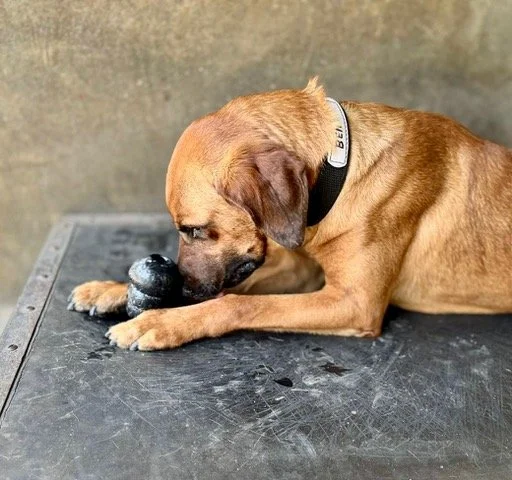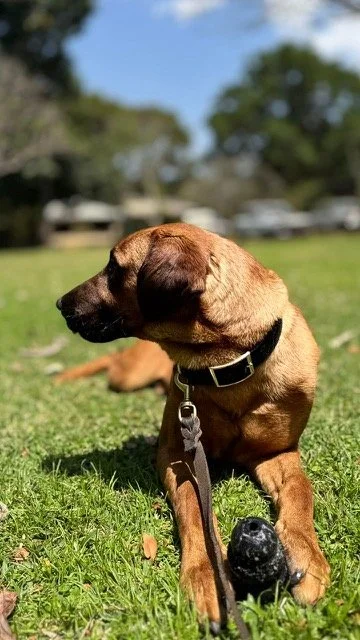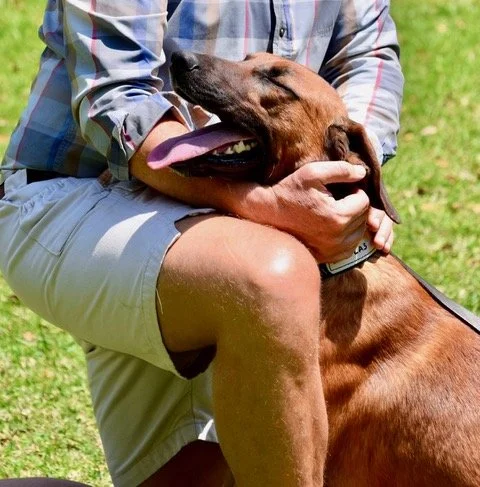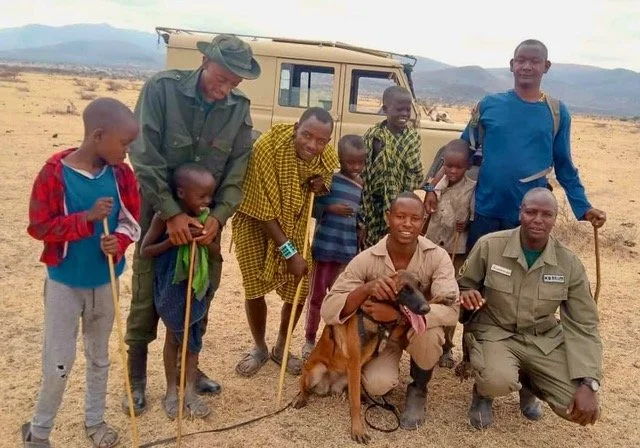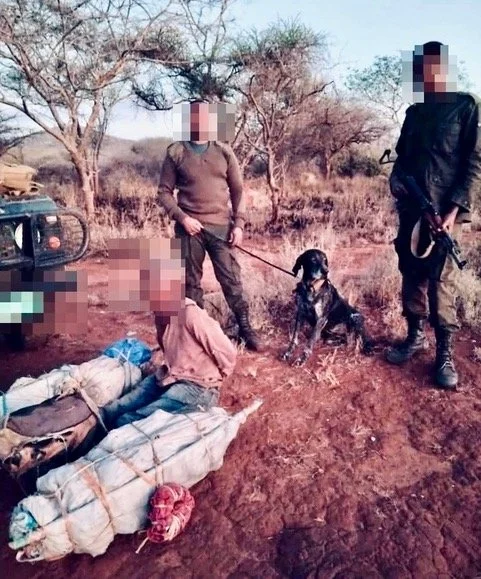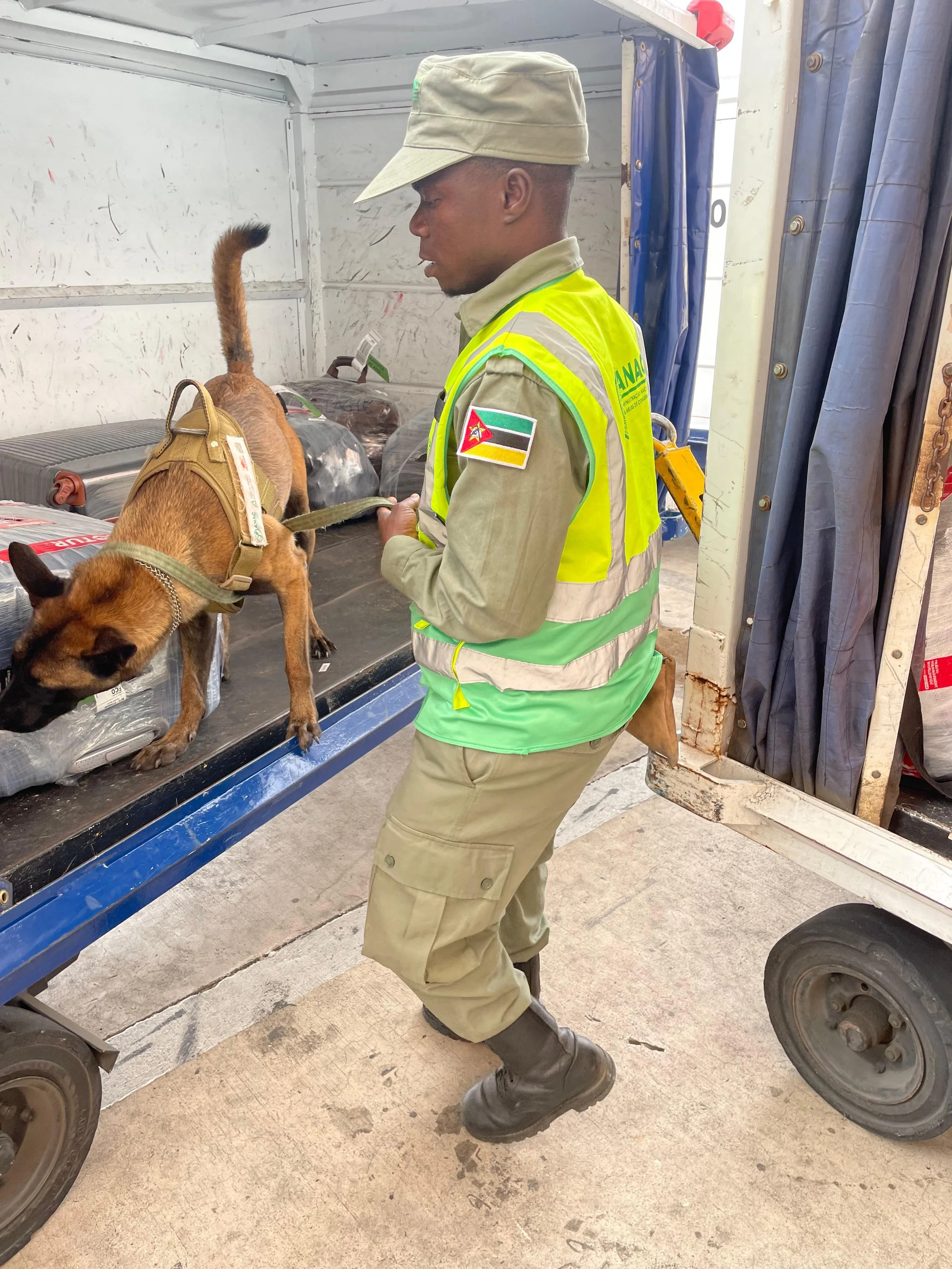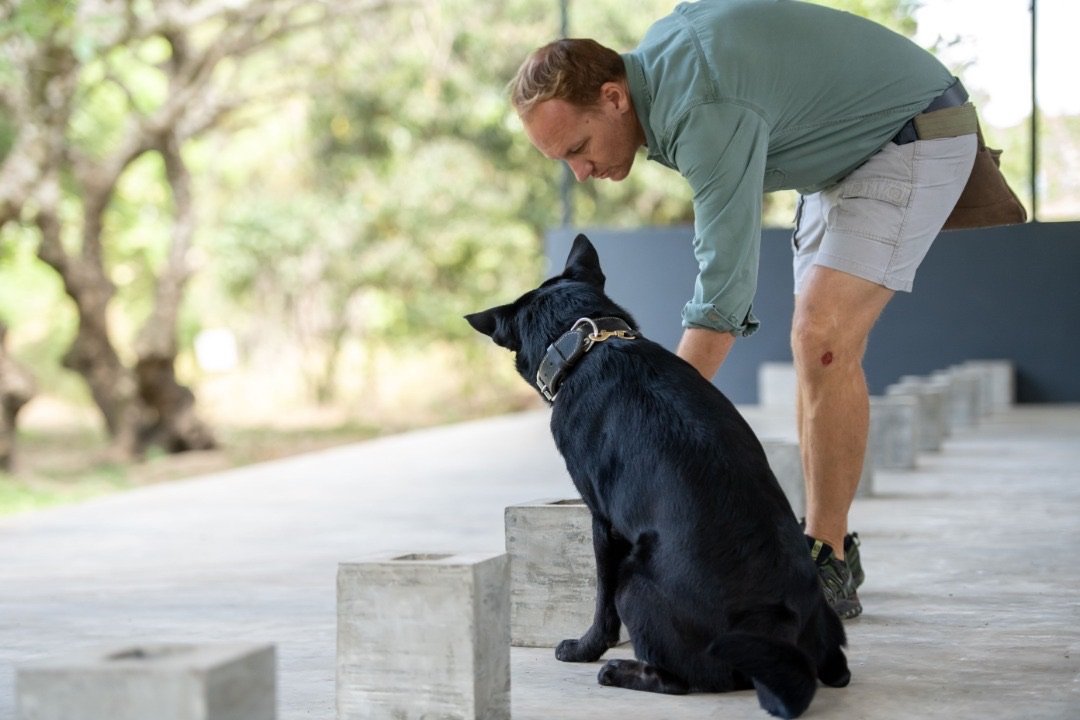News from the Kuru crew
The year just keeps gaining momentum, and there’s so much to share. I’m incredibly proud of all we’ve achieved in the last few months, and I hope you’ll enjoy reading about it as much as we’ve enjoyed making it happen.
The year just keeps gaining momentum, and there’s so much to share. I’m incredibly proud of all we’ve achieved in the last few months, and I hope you’ll enjoy reading about it as much as we’ve enjoyed making it happen.
First and foremost, let’s begin with some important introductions.
Our New Recruits
Our four new tracking dogs from South Africa finally arrived. It was a bit of an ordeal to get them here: they were delayed in Johannesburg, diverted via Uganda, and had to be looked after by friends along the way - but they’ve already begun acclimatising, and are starting their first training sessions.
From left to right, the future stars of conservation: Ben contemplating his Kong; Reuben soaking up some sun; Spike making scents of it all; and Nicolas and I making friends.
Serengeti
Kennels Made New
The Kuru-trained dogs working in Serengeti give Tanzania National Parks (TANAPA) an extra reach across 15,000 square kilometres - and, thanks to Elewana’s Land and Life Foundation, their kennels have had a total makeover.
They replaced rusted metalwork, repainted, expanded the mesh that protects the dogs from tsetse flies, and added a shade-net layer above the roof to cool things down. The difference it has made is remarkable: the dogs are enjoying safer, much more comfortable accommodation, and are better able to do their work. Thank you, Elewana.
Rocco’s Recovery
Rocco, one of our best tracking dogs in the Serengeti, recently gave us a scare. Handlers noticed he was weak and unsteady, and we weren’t sure what was wrong.
We rushed him to a trusted local veterinarian for testing, dialling in advice from experts all over the world. Finally, a retired veterinarian who used to treat our dogs landed on a diagnosis after simply watching a video of Rocco’s gait.
After weeks of rest and care at the Kuru Dog School, he has made a full recovery, and will soon be back at work. Without this incredible network of friends, dog gurus and people who pick up our calls in the middle of the night, Rocco would have been lost, dealing a huge blow to the unit and to the Serengeti.
Manyara
Abigail’s Redemption
Shaya, stationed at Manyara Ranch, had to return to the dog school after Abigail, his canine colleague, nipped his ear in a moment of mischief. Luckily it wasn’t a serious injury, and he is healed and back in action.
I’m glad to report that Abigail has since redeemed herself. We had set a scent trail for training near a Maasai boma, and her presence first attracted children, then the whole family. They joined the exercise, helping to lay tracks and watching her work, delighted by her ability.
These communities have long been allies – the eyes and ears, if you will – of the anti-poaching teams. Abigail reminded us all of the mission that unites us, and of how important these relationships are.
International Rangers Day
TANAPA celebrated International Rangers Day with a ceremony in Tarangire National Park, and invited the Manyara dog team.
It was a proud moment for the handlers and their dogs to stand alongside rangers from across Tanzania, representing the contribution that canine teams make to protecting wildlife and supporting national conservation efforts.
Ngorongoro
Canine Conservation for the Crater
The Ngorongoro Conservation Area is a crucial wildlife zone – and even more so since white rhinos have been introduced into the crater. Some of the NCAA senior management, who previously worked for Tanzania Wildlife Management Authority (TAWA) and TANAPA, have had direct experience of the difference dogs can make, and asked us to help them establish their own dog unit.
We’ll be helping them with tracking dogs to support ranger operations, and detection dogs at the main Ngorongoro Crater entrance. This entrance is the gateway to the entire Serengeti ecosystem: good detection dogs sniffing out wildlife products and bush meat promises significant impact. We can’t wait to start.
Mkomazi
Tracking Down Crime
Recently, rangers in the Mkomazi ecosystem spotted tracks in the hills and called in the dog unit.
Thomas picked up the trail and led the team to a poacher who had just killed a giraffe and was carrying large cuts of meat. He was apprehended on the spot.
A few days later, Finn sniffed out an astonishing 25 snares in one day. It’s a stark reminder of how many are still set in these landscapes – but also of how effective the dogs are at removing them before they can do harm.
Each success strengthens the message: those who try to poach in these protected areas will be caught. The more the dogs find, the fewer poachers dare to enter.
Further Afield
Watson and Big Life
I have always been inspired by Big Life Foundation and the incredible work they do - so it’s been a real honour to support their efforts with some canine assistance.
Watson is one of their Malinois pups that we’ve been training in the art of tracking, and I’m proud to say he’s ready for action. We recently dropped him and a trainer in Kenya to get him going on-site, so he can begin his career combating wildlife crime.
Mozambique Detection Dogs
The dogs we deployed to Mozambique’s Maputo Airport have settled in, and already have their noses to the ground.
They’re searching cargo and luggage airside, and though it’s still early days, we’ve been excited to see the teams adapting quickly and working smoothly.
Your generosity makes our work possible, and without our incredible supporters, we wouldn’t be able to keep up this fight to protect Africa’s precious tracts of wilderness.
Thanks as ever,
Will and the Kuru crew
Kuru in a nutshell
I’ve just returned from an incredible trip to the States, where I was met with so much love and support for Kuru. It’s landed me home with even more zeal for our mission, buoyed up by the many kind folk who truly believe in the work we’re doing - and ready to hit the ground running.
One thing I got asked a lot was - how does it all work? I learned that people want to be able to tell their friends about Kuru’s conservation dogs, so I put together this cheat sheet - and, hopefully, a compelling case for supporting us.
It all starts with…
The Kuru Dog School
This is the heart - the hub, the nerve centre, the mothership. It’s where our kennels are, where we do all of our training, and the base from which we provide logistics and support for the dog teams that are out in the field.
I often compare it to a garage: if you have a fleet of trucks, there’s a base they run from, and it’s where they come back to for maintenance and repair. If dogs are sick, or need retraining, they come back home to the dog school where we get them back in ship-shape so they can do the best work possible.
From here, we deploy dog teams to…
Ports, airports and borders
Global crime syndicates smuggle illegal wildlife products out of Africa and to international markets. Our detection dogs sniff bags, cargo, shipping containers and vehicles to intercept contraband like ivory, rhino horn, pangolin scales, bushmeat… our presence at these trafficking hotspots is a disruptor: knowing nothing makes it past our dogs means it’s not worth it for smugglers to use this channel for their ill-gotten goods any more.
Case Study | Mozambique
It can feel like whack-a-mole: as soon as you bring the hammer down on one spot, the problem pops up in another. In Mozambique though, we have detection teams at no fewer than four of Mozambique’s international airports, and tracking/de-snaring teams in two of their national parks too. This just makes poaching and trafficking way more work than it’s worth: knowing they or their products will be found out skews the cost-benefit analysis less favourably, and they either move elsewhere, or find another line of work.
Of course, the greater our footprint - or pawprint rather - the narrower the gap we leave for criminals to exploit. We’ve got teams at two of Tanzania’s international airports, and one of Uganda’s - and we hope to expand to more.
2. Ranger support
We deploy dog teams in wildlife areas so that they can sniff out poachers, and also detect snares. Snares, often made of thin wire, are nooses that tighten around the animal they trap, keeping them in place until the poacher can return. This results in deaths and injuries too cruel to describe; elephants with severed trunks are but one example.
Case Study | Serengeti
Poachers will disguise their snares in foliage, so if you can imagine trying to look for hidden strands of wire in thousands of acres of grassland - it’s a needle-in-a-haystack scenario. Luckily, our dogs can smell them.
Because the wire carries the scent of the poacher that laid them, our teams can pull up kilometres of snares in a day, all while tracking the perpetrator down - sometimes right to his home.
Dog teams stationed in Serengeti, in collaboration with Tanzania National Parks, save the lives of countless animals every day by sniffing out snares.
3. Mobile canine unit
This is an exciting Kuru innovation and we’re waiting for the right partner to pioneer it with - essentially, it’s the ultimate support package to wildlife authorities who need immediate help tackling poaching.
We’ve designed small, semi-mobile tracking dog units that can be deployed at a moment’s notice, with the agility to step into any wilderness area where rangers need some anti-poaching assistance.
Each unit will consist of two tracking dogs, two vehicles, mobile kennels, tentage, and equipment for three handlers, drivers, and game scouts. These self-contained teams will be ready for immediate action, and can operate autonomously in the remotest of areas for 2-3 months before rotating with another team.
4. Consulting and support
We’ve got decades of dog experience to draw from, and because we’ve found a way that really works - we want to share it with the world. I firmly believe that ego has no place in this fight to protect what we love, and I will always make myself available to troubleshoot, train, brainstorm, and generally do whatever we can to support initiatives that are trying to turn the tide on wildlife crime.
Why we’re donor-funded
Some people ask why we raise funds for Kuru instead of charging top-dollar for our services. The reason: we never want our offering to be unaffordable. The governments and wildlife authorities we serve are doing the best they can; they want and need our help - but a hefty price tag would put us out of reach.
So, our aim is to raise enough to run the Kuru Dog School, and let our partners chip in what they can for the services we provide. When you’re in it for the outcome and not the bottom line, a little really does go a long way.
As always, thank you so much for your support.
Will and the Kuru team
Dog tales from Kuru
The year is off to a cracking start, and though we’ve only got as far as March, Kuru has clocked up so much good news that I just had to share it.
Our 501(c)(3) is here, our dogs are back on Manyara Ranch, we’ve been training handlers from all over Africa, and our Big Life partnership is blossoming.
The year is off to a cracking start, and though we’ve only got as far as March, Kuru has clocked up so much good news that I just had to share it.
Our 501(c)(3) is here
After a long wait, our 501(c)(3) registration is finally official.
This is a big moment for Kuru - now we can accept tax-deductible donations directly in the U.S.
It’s taken time and effort to get here, and we’re excited to put this to good use. If you’d like to contribute, hit the button below - we would be so very grateful.
Our return to the Ranch
Charles Foley, in his ‘Mammals of Tanzania’ book, wrote about Manyara Ranch’s incredible wealth of flora and fauna. If you were to walk 100 miles in a straight line from Tarangire to the Serengeti - which would take you right across the Ranch - you would transect as much biodiversity as you would in the Amazon.
It is such a special place, and to my mind, anywhere wild and beautiful deserves to be protected - but the fact that it is such a biodiversity hotspot makes its conservation all the more important.
Our dog teams have had a huge impact here, bringing ivory poaching to an almost complete stop.
Tragically, toward the end of last year, political challenges meant the dogs returned to Kuru - and almost immediately, poaching began again.
Seeing this, the government asked to bring them back. We’re incredibly proud to say that together, Kuru and Honeyguide have made it happen. A few weeks ago, we loaded up a car with a vet kit, dog food, equipment, and two of our finest dogs - and they’re out there doing what they do best, stopping wildlife crime in its tracks.
Handlers in training
Last year, we were approached by an NGO looking to establish dog teams to combat poaching and trafficking in Mozambique’s key conservation areas. From my years working with de-mining dogs, I knew some great Mozambican handlers, one of whom I trained 25 years ago and has been working with detection dogs ever since. I got in touch with them, and we tracked down the right people for the job.
Now, we’re back working side by side, bringing decades of combined experience to training the next generation.
Rangers from Mozambique’s Administração Nacional das Áreas de Conservação are now learning to be detection dog handlers, focused on finding illegal wildlife products.
We’re also training more handlers for Tanzania Wildlife Management Authority (TAWA), with whom we have a long-standing relationship. These rangers will be working in Dar es Salaam and Northern Tanzania.
It’s a special thing to see two groups - handlers from different parts of Africa - working together, learning the Kuru way. Some moments are challenging, but the end result is always worth it: experienced handlers guiding the new guys, old faces welcoming new family members, all united by a shared mission.
And that’s really what Kuru is about - taking everything we’ve learned over the years and putting it to work for conservation.
Big Life partnership
Big Life Foundation’s approach to conservation has long inspired the Kuru approach, and it is an honour to be partnering with them.
Their work includes protecting the wildlife and habitats in the Amboseli-Tsavo-Kilimanjaro ecosystem, and they want to use dog teams to help their efforts.
We are in the process of training dogs and handlers that will be deployed in these areas, and we can’t wait to see the impact they will have.
A canine conference
The African Canines in Conservation Conference is coming up this month, and they’ve kindly invited me to be one of their keynote speakers. I’m very much looking forward to being in the company of so many fellow dog enthusiasts - always a great space to share knowledge and learn.
Guardians of the Wild: The Ongoing Impact of Kuru the Conservation Dog
Kuru the Conservation Dog deploys trained dogs to protect Africa’s wildlife by reducing poaching, building partnerships with governments, and safeguarding endangered species. This update highlights our work and impact in 2024.
DECEMBER 2024
This briefing provides an update on the ongoing work of the Kuru Conservation Dog Programme. Despite facing significant financial challenges this year, we are eagerly awaiting the approval of our US 501(c)(3) status, which will enable more US donors to contribute to our efforts. In the meantime, we have been fortunate to receive support from a few generous donors, including direct donations to our Tanzanian account, assistance from the Honeyguide Foundation, and contributions from visiting tourists from A&K, Nomad, and Royal African Safaris. To help keep things going, Will has also taken on contracts with other NGOs, supporting detection dog teams in Ethiopia and helping to establish units in Northern Mozambique. Thanks to this combination of support and efforts, we have continued protecting key wildlife areas and training new detection dogs for conservation dog units. We’re also expanding our partnerships across Africa, with collaborations in Kenya, Mozambique, and Botswana. The individual dogs themselves have played a major role in the success of our work, demonstrating how a few well-trained dogs can protect vast landscapes and help save endangered species from poaching.
WORKING CLOSELY WITH GOVERNMENTS
One of the most rewarding aspects of our work has been the strong relationships we’ve built with governments across Africa. Governments appreciate our approach because we are easy to work with, respectful, and focused on helping rather than imposing a model that mirrors colonial-era conservation efforts. We recognise that governments face enormous challenges and often have limited resources, but many within those systems truly care about protecting wildlife and preserving their natural heritage. Our role is to offer support, work alongside them, and provide solutions that address their specific needs—never to judge.
This collaborative and respectful approach is central to how we operate, and it’s why governments continue to request our assistance in protecting their wildlife. We have seen firsthand how effective conservation partnerships can be when both sides are committed to a shared goal.
PROTECTING THE MANYARA LANDSCAPE: A DECADE OF SUCCESS WITH KURU DOGS
For over a decade, conservation dogs have been at the forefront of efforts to protect Manyara, playing a key role in safeguarding both the landscape and its wildlife. Before the canine unit was first introduced, 16 elephants were poached in the landscape in a single year. However, with the arrival of these well-trained, highly effective dogs, everything changed.
These dogs, capable of tracking poachers across vast distances, became a powerful deterrent. In their first year of service, only one elephant was lost, and in the years that followed, no further elephants were poached. The reputation of these dogs as swift trackers spread quickly, creating a secure environment for the wildlife on the ranch.
A SMALL UNIT WITH A BIG IMPACT
The success at Manyara Ranch highlights how a small, well-managed team can make an enormous difference. A few highly trained dogs, working in close coordination with dedicated handlers, have been able to protect vast landscapes simply through their presence. This approach has proven to be one of the most effective conservation tools available today, demonstrating that significant impact can be achieved with modest resources.
However, when the dogs were relocated to the Kuru dog school three months ago due to local political challenges, poaching sadly resumed. Just last month, an elephant was killed—the first in many years. In response, the government has requested that the dogs return to the Makuyuni area, recognising their vital role in maintaining security and deterring poaching.
EXPANDING OUR REACH: COLLABORATIONS WITH BIG LIFE, MOZAMBIQUE, AND BOTSWANA
Despite financial constraints, we’ve managed to expand the impact of conservation dogs across Africa, thanks to the generosity of a few key donors and support from organisations like the Honeyguide Foundation. In Kenya, we are working closely with Big Life Foundation, supporting their tracking dogs to combat poaching in critical areas. Our expertise and training are enhancing their unit’s effectiveness in protecting wildlife.
In Southern Africa, we have been approached by an NGO seeking to establish a dedicated dog programme for parks in Mozambique. Although there are options available in South Africa, the organisation specifically sought out Kuru due to our strong reputation for quality training and long-term success. We are excited to bring our experience to new areas of Mozambique, where this new programme will focus on safeguarding endangered species in key conservation areas.
Furthermore, we are in discussions with the Department of Wildlife and National Parks (DWNP) in Botswana to help establish the first DWNP tracking dog unit in the Okavango Delta. Supported by donor funding, this unit would represent a major step forward in protecting one of Africa’s most significant wildlife habitats. We are looking forward to supporting this important initiative.
REPLACING OLDER DOGS AND TRAINING NEW RECRUITS FOR TAWA DETECTION UNITS
In Tanzania, we are also planning to replace some of the older dogs currently working in TAWA detection units, particularly those stationed at airports. These older dogs will be replaced with younger recruits who will undergo intensive training to ensure they can effectively detect illegal wildlife products. This initiative is vital to maintaining the long-term efficiency of the units and securing the future of the project. By bringing in fresh recruits and equipping them with the skills they need, we will continue to improve the effectiveness of these units.
LAND PROTECTION ACROSS TANZANIA
Kuru-trained dogs continue to play a critical role in protecting vital landscapes across Tanzania, including:
• Serengeti National Park: 14,750 square kilometres (3.64 million acres)
• Mkomazi National Park: 3,245 square kilometres (802,000 acres)
• The Manyara Landscape: Over 8,000 square kilometres (1.98 million acres)
Through their ability to track poachers, remove snares, and serve as a strong deterrent to illegal activities, our dogs are ensuring the protection of these vast ecosystems and helping secure the future of endangered species. Their work in detecting and eliminating snares is particularly important in mitigating the threats faced by wildlife in these regions.
THE ROLE OF THE KURU DOG SCHOOL IN HEALTH, RECOVERY, AND KNOWLEDGE SHARING
Our dog school is not just a training facility; it is also a centre for ensuring the health and well-being of dogs throughout their working lives. Recently, we had two dogs fall seriously ill—one with an infection and another with trypanosomiasis (tryps). Thanks to the expertise, care, and well-established systems at the school, both dogs made a full recovery. Without such swift and professional care, the outcome could have been very different.
Beyond caring for our own dogs, we share our knowledge and experience with partners, helping them replicate our successes in their own dog programs. This ‘drop-in institutional knowledge’ strengthens conservation efforts more broadly, ensuring that our work continues to contribute to global conservation goals
The Kuru Conservation Dog Programme continues to demonstrate that a small team of well-trained dogs can make an extraordinary impact on wildlife conservation.
The success at Manyara Ranch and in the Serengeti are just two examples of how our dogs are helping to protect vast landscapes and ensure the survival of endangered species. As we expand our partnerships in Kenya, Mozambique, and Botswana, we anticipate even greater achievements ahead.
We remain deeply grateful for the support that allows us to continue this vital work, and we look forward to further expanding our efforts in the months and years to come.
The Kuru Team
If you'd like to support our work, here are a few ways to contribute.
For tax-deductible donations, we’ve partnered with Conservancy Guardians and the Royal African Foundation, who will direct your donations to Kuru and provide you with a tax receipt.
For USA donations, visit Royal African Foundation
For USA and UK donations, visit Conservancy Guardians
Both organisations share Kuru’s ethos, focusing on minimising overhead costs and ensuring funds go straight to where they’re needed most — on the ground.
If you’re not worried about tax deductibility or are donating from outside UK and USA, simply click here.

